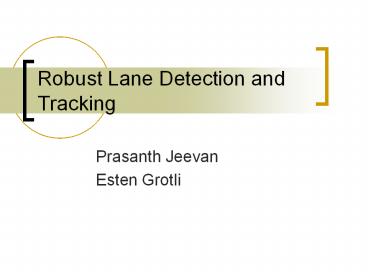Robust Lane Detection and Tracking - PowerPoint PPT Presentation
Title:
Robust Lane Detection and Tracking
Description:
Autonomous driving. Driver assistance (collision avoidance, more precise driving directions) ... work with Berkeley-Sydney Driving Team to use other sensors ... – PowerPoint PPT presentation
Number of Views:494
Avg rating:3.0/5.0
Title: Robust Lane Detection and Tracking
1
Robust Lane Detection and Tracking
- Prasanth Jeevan
- Esten Grotli
2
Motivation
- Autonomous driving
- Driver assistance (collision avoidance, more
precise driving directions)
3
Some Terms
- Lane detection - draw boundaries of a lane in a
single frame - Lane tracking - uses temporal coherence to track
boundaries in a frame sequence - Vehicle Orientation- position and orientation of
vehicle within the lane boundaries
4
Goals of our lane tracker
- Recover lane boundary for straight or curved
lanes in suburban environment - Recover orientation and position of vehicle in
detected lane boundaries - Use temporal coherence for robustness
5
Starting with lane detection
- Extended the work of Lopez et. al. 2005s work on
lane detection - Ridgel feature
- Hyperbola lane model
- RANSAC for model fitting
- Realtime
- Our extension Temporal coherence for lane
tracking
6
The Setup
- Data University of Sydney (Berkeley-Sydney
Driving Team) - 640x480, grayscale, 24 fps
- Suburban area of Sydney
- Lane Model Hyperbola
- 2 lane boundaries
- 4 parameters
- 2 for vehicle position and orientation
- 2 for lane width and curvature
- Features Ridgels
- Picks out the center line of lane markers
- More robust than simple gradient vectors and
edges - Fitting RANSAC
- Robustly fit lane model to ridgel features
7
Setup
8
Setup
9
Setup
10
The Setup
- Data University of Sydney
- 640x480, grayscale, 24 fps
- Suburban area of Sydney
- Lane Model Hyperbola
- 2 lane boundaries
- 4 parameters
- 2 for vehicle position and orientation
- 2 for lane width and curvature
- Features Ridgels
- Picks out the center line of lane markers
- More robust than simple gradient vectors and
edges - Fitting RANSAC
- Robustly fit lane model to ridgel features
11
Lane Model
- Assumes flat road, constant curvature
- L and K are the lane width and road curvature
- ? and x0 are the vehicles orientation and
position - ? is the pitch of the camera, assumed to be fixed
12
Lane Model
- v is the image row of a lane boundary
- uL and uR are the image column of the left and
right lane boundary, respectively
13
The Setup
- Data University of Sydney (Berkeley-Sydney
Driving Team) - 640x480, grayscale, 24 fps
- Suburban area of Sydney
- Lane Model Hyperbolic
- 2 lane boundaries
- 4 parameters
- 2 for vehicle position and orientation
- 2 for lane width and curvature
- Features Ridgels
- Picks out the center line of lane markers
- More robust than simple gradient vectors and
edges - Fitting RANSAC
- Robustly fit lane model to ridgel features
14
Ridgel Feature
- Center line of elongated high intensity
structures (lane markers) - Originally proposed for use in rigid registration
of CT and MRI head volumes
15
Ridgel Feature
- Recovers dominant gradient orientation of pixel
- Invariance under monotonic-grey level transforms
(shadows) and rigid movements of image
16
The Setup
- Data University of Sydney
- 640x480, grayscale, 24 fps
- Suburban area of Sydney
- Lane Model Hyperbola
- 2 lane boundaries
- 4 parameters
- 2 for vehicle position and orientation
- 2 for lane width and curvature
- Features Ridgels
- Picks out the center line of lane markers
- More robust than simple gradient vectors and
edges - Fitting RANSAC
- Robustly fit lane model to ridgel features
17
Fitting with RANSAC
- Need a minimum of four ridgels to solve for L, K,
?, and x0 - Robust to clutter (outliers)
18
Fitting with RANSAC
- Error function
- Distance measure based on of pixels between
feature and boundary - Difference in orientation of ridgel and closest
lane boundary point
19
Temporal Coherence
- At 24fps the lane boundaries in sequential frames
are highly correlated - Can remove lots of clutter more intelligently
based on coherence - Doesnt make sense to use global (whole image)
fixed thresholds for processing a (slowly)
varying scene
20
Classifying and removing ridgels
- Using the previous lane boundary
- Dynamically classify left and right ridgels
- per row image gradient comparison
- far left and far right ridgels removed
21
Velocity Measurements
- Optical encoder provides velocity
- Model for vehicle motion
- Updates lane model parameters ? and x0 for next
frame
22
Results, original algorithm
23
Results, algorithm w/ temporal
24
Conclusion
- Robust by incorporating temporal features
- Still needs work
- Theoretical speed up by pruning ridgel features
- Ridgel feature robust
- Lane model assumptions may not hold in
non-highway roads
25
Future Work
- Implement in C, possibly using OpenCV
- Cluster ridgels together based on location
- Possibly work with Berkeley-Sydney Driving Team
to use other sensors to make this more robust
(LIDAR, IMU, etc.)
26
Acknowledgements
- Allen Yang
- Dr. Jonathan Sprinkle
- University of Sydney
- Professor Kosecka
27
Important works reviewed/considered
- Zhou. et. al. 2006
- Particle filter and Tabu Search
- Hyperbolic lane model
- Sobel edge features
- Zu Kim 2006
- Particle filtering and RANSAC
- Cubic spline lane model
- No vehicle orientation/position estimation
- Template image matching for features































